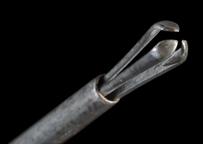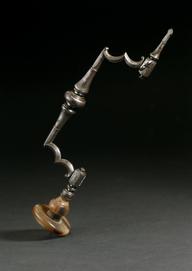

Signoroni-type tourniquet, London, England, 1866-1880
- maker:
- Arnold and Sons




Signoroni's tourniquet, adjustable horse-shoe frame with end pressure pads, by Arnold, London, c. 1850
The Signoroni-type tourniquet, designed by a Milanese surgeon, is horse-shoe shaped with adjustable pads. It is used in the treatment of heavy bleeding to stop the flow of blood. The pressure is concentrated on the artery and not the surrounding blood vessels as would be the case with earlier designs. Arnold & Sons were a major surgical instrument maker located in West Smithfield, London, where they were ideally placed to supply several nearby hospitals.
Details
- Category:
- Surgery
- Collection:
- Sir Henry Wellcome's Museum Collection
- Object Number:
- A600706
- Materials:
- frame, steel, pads, steel, pads, wood and pads, felt
- Measurements:
-
overall: 108 mm x 270 mm x 145 mm, .57kg
- type:
- tourniquet




